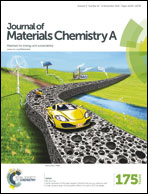Soybean-derived hierarchical porous carbon with large sulfur loading and sulfur content for high-performance lithium–sulfur batteries†
Abstract
An hierarchical porous carbon nanostructure with intrinsic O- and N-dopants and an ultrahigh specific surface area of 1500 m2 g−1 is reported towards the goal of designing and achieving a better sulfur electrode for lithium–sulfur batteries (LSBs) that can provide both large sulfur loading and large sulfur content and are based on a facile fabrication process. This nanostructure was derived from crude soybeans in a facile pyrolysis process. Using it as a sulfur host, the S/C active composite with 80% sulfur content was made. Cells with different sulfur loadings were investigated and were found to demonstrate large capacity, high coulombic and energy efficiencies, and high cycling stability. In particular, for a sulfur loading of 5.5 mg cm−2 and a sulfur content of 80%, cells displayed a specific capacity of ca. 950 mA h g−1, which corresponds to an areal capacity of 5.2 mA h cm−2. Such a performance moves LSB technology closer to practical applications.



 Please wait while we load your content...
Please wait while we load your content...